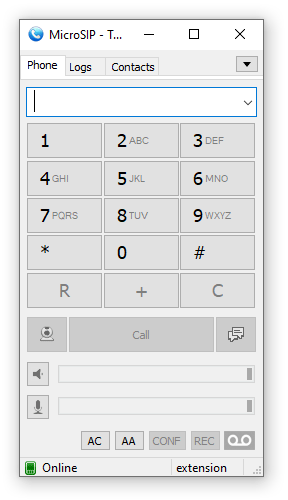MicroSIP datasheet
Jump to navigation
Jump to search
MicroSIP is a SIP softphone based on the PJSIP stack available for Microsoft Windows. It facilitates high quality VoIP calls based on the open SIP protocol.
| IP Ports and Protocols used by SIP Devices. The following ports are associated with a successful communication: |
| IP Ports and Protocols used by SIP Devices | |||
|---|---|---|---|
| Trust Over IP | Port | Type | Description |
| SIP Server Ex. 192.168.1.1 | 5060 | UDP | SIP endpoints |
| SIP Server Ex. 192.168.1.1 | 10000:65000 | UDP | RTP/SRTP Media |
| A security group controls the traffic that is allowed to our IP; reach and leave the resources that it is associated with. |
- General
- Softphone usage modes
- Single call mode - single window, basic functionality. Enabled by default.
- Extended mode - two windows, multiple calls, conferences, attended transfers.
- Communication types
- Calls through SIP server / PBX - select "Add Account" after installing.
- Direct calls by IP address (or domain name). Works out of the box, using the "Local Account".
After automatic startup or when you close the main window MicroSIP will be minimized to the system tray.
MicroSIP does not require the installation of additional libraries, runtimes or frameworks.
- Dialpad
Mainly used for dialing or sending dual tones (DTMF). Various input formats are supported.
- Examples
- 1-800-567-46-57
- 1234
- 1234@sip.server.com
- 1234@sip.server.com:5043
- 192.168.0.55
- Or even complete SIP URI with optional microsip extensions
- "Name" <sip:extension@sip.microsip.org;parameter1=xxx?Custom-Header=yyy>,dtmf_sequence
- There is sound quality indication

- Control switches and buttons
- DND (switch) - Do not disturb mode
- FWD (switch) - Automatic forwarding of incoming calls. Set up in the settings
- AC (switch) - Automatic conference for incoming calls after answering a call
- AA (switch) - Automatic answer. Set up in the settings
- CONF (button) - Invite a participant to a conference call
- REC (button) - Current call recording. Set up in the settings
- Account
- SIP server
- Your account SIP server.
- SIP proxy
- Your account SIP proxy or a chain of proxies.
- Examples: 192.168.1.1, 192.168.1.1:5070, 192.168.1.1 192.168.15.1, 192.168.1.1;hide, ";hide" parameter can solve impossibility of registration or calls due to server configuration.
- Username
- Your account username.
- Domain
- Your account domain.
- Login
- Username for authentication. If empty, will be used Username.
- Password
- Your account password.
- Display name
- Your name, remote party will see it in incoming calls and messages.
- Dialing Prefix
- International calling prefix for numbers in local format (must begin with "+" or "00"); or a simple prefix for each dialing phone number.
- Dial Plan
- Transforms dialing number according to pattern. Numbers that do not match any patterns are blocked. Patterns are separated by a pipe symbol: |. The entire value can be enclosed in brackets ().
x "x" represents any character [sequence] Enter characters within square brackets to create a list of accepted digits. Numeric range: enter [2-9] to allow the user to enter any one digit from 2 through 9. Numeric range with other characters: enter [16-9*] to allow the user to enter 1, 6, 7, 8, 9, or *. <dialed:substituted> Replaces one sequence with another. Or inserts some sequence inside a number: <:substituted> Example 1 : <8:1555>xxxxxxx If user dials 81234567, the system transmits 15551234567. Example 2 : <:1>xxxxxxxxxx If user dials 1234567890, the system transmits 11234567890.
. (period symbol) Represents zero or more entries of the previous digit. Example, 01. => 0, 01, 011, 0111, ...; x. => matches any dialed number.
- Example: Replace + with 00, allow any other numbers.
<+:00>x.|x.- Complex rule example:
[3469]11|0|00|1[2-9]xx[2-9]xxxxxx|<:1>[2-9]xx[2-9]xxxxxx|<:1618>[2-9]xxxxxx|<:1618555>6[2-4]xx
